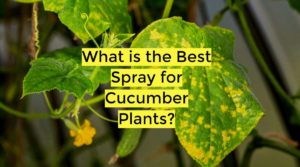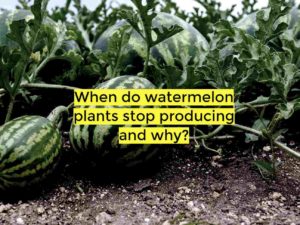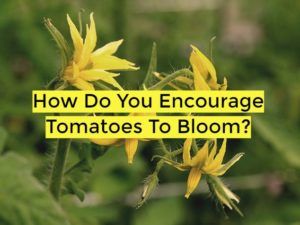As the warm summer days come close, many gardening enthusiasts get excited about their harvest of fresh, juicy tomatoes from their gardens. Tomato plants are a popular choice for home gardeners due to their ease of cultivation and delicious fruits. However, like all living beings, tomato plants have a finite lifespan, and they stop producing ripe tomatoes. In this blog, we will explore when tomato plants stop producing and the reasons behind it. We will also learn how to identify when a tomato plant is done producing, what to do if your tomato plant is not producing as expected, and the common causes of reduced tomato production.
When Do Tomato Plants Stop Producing and Why?
Tomato plants are typically considered annuals, meaning they complete their life cycle within a year.
However, in some regions with mild climates, tomato plants may behave as perennials and produce fruit for several years under suitable conditions.
The lifespan and fruiting period of tomato plants vary based on various factors, including the plant’s type, growing conditions, and care.
1. Determinate Tomato Plants
Determinate tomato plants are bred to have a relatively short and compact growth habit.
They produce fruit over a concentrated period, usually two to three months, and then gradually decline.
Once determinate tomato plants have produced all their fruit, they focus their energy on ripening the remaining tomatoes before reaching the end of their productive cycle.
2. Indeterminate Tomato Plants
Indeterminate tomato plants, on the other hand, have a more extended growth habit and can continue producing fruit throughout the growing season until frost or adverse conditions halt their productivity. These plants grow taller and require staking or trellising for support.
Indeterminate tomatoes keep flowering and producing fruit as long as they receive adequate care and favorable growing conditions.
How Do You Know When a Tomato Plant is Done Producing?
Recognizing when a tomato plant is done producing requires some observation and understanding of its growth habits.
Here are some signs that indicate your tomato plant is nearing the end of its fruiting period:
1. Ripening of the Last Fruits: As the tomato plant nears the end of its life cycle, it will put more energy into ripening the last remaining tomatoes on the vine.
You’ll notice that the number of green fruits decreases, and the ripe tomatoes become more frequent.
2. Yellowing and Drying Leaves: As the tomato plant exhausts its energy reserves, its lower leaves may start to yellow and dry out.
This is a natural part of the plant’s senescence process as it prepares for the end of its life cycle.
3. Reduced Flowering: A tomato plant reaching the end of its productive phase may have fewer flowers or stop flowering altogether.
This reduction in flower production is a clear indicator that the plant is concluding its fruiting period.
4. Thinning of Foliage: Towards the end of the growing season, you might notice a gradual thinning of the foliage as the plant redirects its resources to ripen the remaining fruit.
What to Do if Your Tomato Plant is Not Producing?
If your tomato plant is not producing as expected, there are several factors to consider and steps you can take to encourage fruiting:
1. Insufficient Sunlight
Tomatoes require ample sunlight to thrive and produce fruit.
Ensure that your tomato plant receives at least 6-8 hours of direct sunlight daily.
If it is planted in a shady area, consider relocating it to a sunnier spot.
2. Inadequate Watering
Underwatering or overwatering can both negatively impact fruit production. Keep the soil consistently moist but not waterlogged.
A drip irrigation system can help provide a steady supply of water to the roots.
3. Nutrient Imbalance
A lack of essential nutrients, especially phosphorus and potassium, can hinder flower and fruit development.
Use a balanced fertilizer or amend the soil with organic matter to ensure your tomato plant receives the nutrients it needs.
4. Temperature Extremes
Tomato plants thrive in warm temperatures, and extreme heat or cold can disrupt fruit sets.
Protect your plants from temperature extremes using shade cloth or row covers when necessary.
5. Pruning Technique
Over-pruning or improper pruning can remove the flowering branches, affecting fruit production.
Learn proper pruning techniques for the specific type of tomato plant you have and avoid excessive pruning during the fruiting season.
6. Pests and Diseases
Pests and diseases can damage the plant and reduce fruit production.
Regularly inspect your tomato plants for any signs of infestation or disease and take appropriate measures to address the issue promptly.
What Causes Tomato Plants to Not Produce Tomatoes?
Several factors can contribute to reduced or no tomato production:
Temperature Stress
Extreme temperatures, whether excessively high or unusually low, can disrupt the pollination process in tomato plants.
High temperatures can cause flowers to drop prematurely, preventing fruit formation.
Conversely, low temperatures can hinder pollen germination and reduce flower viability.
To mitigate temperature stress, consider providing shade during scorching days and using row covers or protective measures during chilly nights.
Maintaining a consistent temperature range will help ensure optimal flower and fruit development.
Lack of Pollination
Tomatoes require successful pollination to set fruit. In some cases, pollinators might be scarce or not present in your garden.
Without pollination, flowers wither and fall off without producing fruit.
To address this, you can become a pollinator by gently shaking the flower clusters or using a small brush to transfer pollen between flowers.
Creating a pollinator-friendly environment with a diverse range of flowering plants can also attract bees and other beneficial insects to aid in pollination.
Nitrogen Overload
Excessive nitrogen in the soil can lead to an abundance of lush foliage at the expense of flower and fruit development.
When tomato plants receive too much nitrogen, they prioritize leafy growth rather than producing flowers and setting fruit.
Balancing the nutrient levels in the soil is essential for promoting healthy growth and fruiting.
Use a balanced fertilizer with lower nitrogen content and higher phosphorus and potassium levels to support flower formation and fruit set.
Improper Watering
Inconsistent or inadequate watering practices can hinder fruit production in tomato plants.
Insufficient water can lead to flower drop and fruit abortion, while overwatering can cause root rot and impact overall plant health.
Maintain consistent soil moisture by watering deeply and evenly, allowing the soil to dry slightly between watering sessions.
A drip irrigation system or soaker hose can be beneficial in delivering water directly to the plant roots and preventing waterlogging.
Pests and Diseases
Pest infestations and diseases can significantly impact a tomato plant’s ability to produce fruit.
Pests like aphids, thrips, and whiteflies can damage flowers, affecting fruit sets.
Additionally, fungal diseases like blossom end rot and blight can cause fruit to rot prematurely.
Regularly inspect your tomato plants for any signs of pest activity or disease symptoms and take prompt action with organic or natural remedies to protect your plants.
Lack of Sunlight
Tomatoes thrive in full sunlight, and inadequate light exposure can impede flower and fruit development.
Insufficient sunlight can lead to fewer flowers, lower fruit sets, and smaller fruits.
Ensure that your tomato plants receive at least 6-8 hours of direct sunlight daily.
If they are grown in a shady location, consider transplanting them to a sunnier spot to promote robust flower production and healthy fruit development.
Nurturing Healthy Tomato Plants for a Fruitful Harvest
Understanding when tomato plants stop producing and the factors influencing their fruiting period is essential for any gardening enthusiast.
Determinate tomato plants have a fixed fruiting period, while indeterminate varieties can produce fruit until adverse conditions arise.
By recognizing the signs of a tomato plant reaching the end of its productive cycle and providing appropriate care and attention, you can optimize its fruit production.
To ensure a bountiful harvest of juicy tomatoes, provide your tomato plants with adequate sunlight, consistent watering, proper fertilization, and protection from pests and diseases.
Regularly observe your tomato plants for signs of stress or reduced fruiting, and take proactive measures to address any issues that arise.
With proper care and gardening know-how, you’ll enjoy a thriving tomato garden and savor the delicious rewards of your hard work come harvest time.




